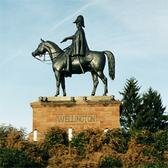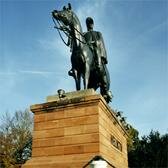Region: South East
Local Authority: Rushmoor
Funding Body: Gainshare and others
Year of Intervention: 2005
Summary: The equestrian monument to the Duke of Wellington, prominently sited on a hill near Aldershot, has been repaired and its setting enhanced. The work has been carried out by the MOD in partnership with various local groups and supporters.
Description: From 1846, the three-times-lifesize equestrian statue of the Duke of Wellington stood on top of the Wellington Arch at Hyde Park Corner. When the arch was dismantled, moved and re-erected in 1882, the statue was not reinstated. At the suggestion of the Prince of Wales (later Edward VII), it was installed on a large sandstone plinth on top of Round Hill at Aldershot in 1885. It was a prominent landmark for troops marching from their barracks to the heathland training area.
Issue: Although at the centre of a carefully-designed planting and footpath layout when first installed at Aldershot, the removal of the perimeter railing to Round Hill and the subsequent neglect of the planting meant that the area became seriously overgrown, and by 2000 the grade II listed, heavily-weathered statue was largely lost to view.
Strategy:
In 2001, mindful of their stewardship responsibilities, MOD Aldershot Garrison founded Project Wellington, a scheme to restore the statue and its landscape, guided by a working party representing local, landscape and historic environment interests. Members of the working party, in addition to MOD, included Hampshire County Council, Rushmoor Borough Council and English Heritage.
Various options were investigated to restore the statue and landscape to their original condition, constrained by a lack of funds within MoD for the repair and refurbishment of a structure officially classified as non-operational. Hampshire County Council agreed to fund the production of a landscape conservation plan which was prepared by Colvin & Moggridge, landscape architects. At the same time, arrangements were made by Defence Estates to grant a lease to the Hampshire Museums Trust, facilitating application to the Heritage Lottery Fund for a grant for refurbishment of the statue and reinstatement of the landscape to its 1880s condition.
Outcome: Although the HLF bid did not succeed, an annual clawback mechanism, Gainshare, which was part of the agreement between the garrison and its facilities contractor, provided funds to refurbish the statue. Subsequently the efforts of soldiers and the Blackwater Valley Countryside Partnership reduced vegetation on the mound so that the whole of the statue and its plinth were once again in view. Defence Estates undertook selective tree surgery to re-establish long views of the monument from nearby roads. Finally, thanks to a complimentary design consultancy from W S Atkins, permanent floodlighting, paid for from funds collected through an appeal, was installed and inaugurated at a special ceremony in November 2005. Interpretation panels have since been erected explaining the history of the statue. The text and illustrations for these panels has been provided by the Friends of the Aldershot Military Museum.
Keywords: DISPLAY AND INTERPRETATION; PRESERVATION AND MAINTENANCE; REPAIR, RECONSTRUCTION, RESTORATION
© English Heritage


